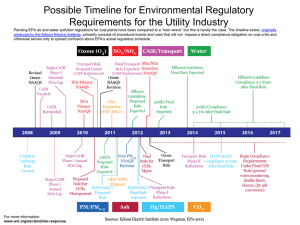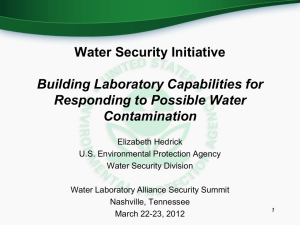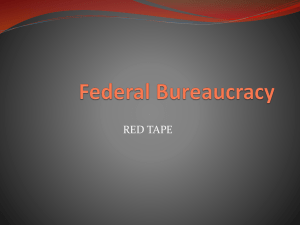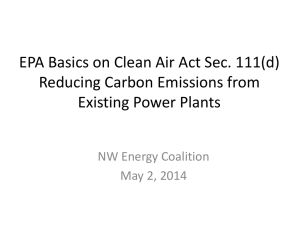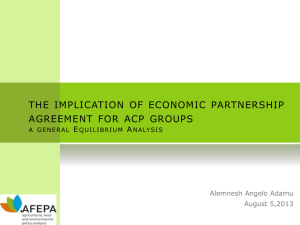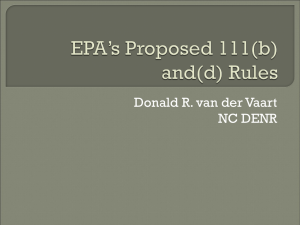Presentation
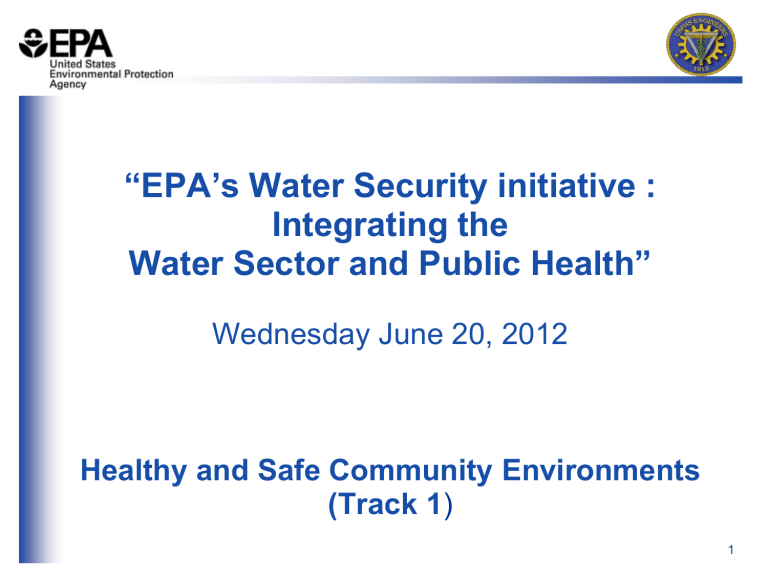
“EPA’s Water Security initiative :
Integrating the
Water Sector and Public Health”
Wednesday June 20, 2012
Healthy and Safe Community Environments
(Track 1
)
1
Presentation Overview
• Background on the Water Security Initiative
• Conceptual design
• Partnering and Public Health
• Conclusions and Resources
Background
• Homeland Security Presidential Directive/HSPD-9
– Establishes a national policy to defend the agriculture and food system against terrorist attacks, major disasters, and other emergencies.
– Signed January 30, 2004
• HSPD-9 requires EPA to
– “ develop robust, comprehensive, and fully coordinated surveillance and monitoring systems . . . for . . . water quality that provide early detection and awareness of disease, pest, or poisonous agents,”
Programmatic Approach of the
Water Security Initiative
Conceptual Design
5
Distribution System Vulnerabilities
• Large, complex, and
accessible:
– Commercial & residential service connections
– Fire hydrants
– Finished water storage
• Difficult to contaminate an entire city via the distribution system, but
– fairly easy to impact small sections or individual buildings
Primary Design Objectives
• Detection of a broad spectrum of contaminant classes
• Achieve spatial coverage of the entire distribution system
• Detect contamination in sufficient time for effective response
• Reliably indicate a contamination incident with a minimum number of false-positives
• Provide a sustainable architecture to monitor distribution system water quality
Dual Use Objectives
• Expanded laboratory capability for emerging source water contaminants
• Enhanced knowledge of distribution system water quality leading to improved operations
• Early detection of undesirable events such as nitrification or corrosion problems
• Improved relationship with public health agencies
• Increased ability to respond effectively to a variety of emergencies
Water quality monitoring
Monitoring Components
Customer complaint surveillance
Enhanced security monitoring
Integrated
Contamination
Warning System
Sampling and analysis
Public health surveillance
System Architecture
Phase I.
Routine Monitoring & Surveillance
Online Water Quality
Possible
Determination
Public Health
Sampling and
Analysis
Enhanced Security
·
Event
Detection
·
Initial
Trigger
Validation
Customer Complaints
Phase II.
Consequence Management
Credibility Determination Actions confirm or rule out contamination and may include:
·
Site Characterization
·
Outside data sources
·
Laboratory confirmation
Response Actions protect public health during the investigation process and may include:
·
Isolation
·
Flushing
·
Public alerts/notifications
Remediation and Recovery restores a system to normal operations and may include:
·
System characterization
·
Remedial action
·
Post-remediation activities
Partnering and Public Health
11
Partner Organizations
Federal Bureau of
Investigation
Centers For Disease
Control and Prevention
EPA Regional Offices EPA Criminal
Investigation Division
State Emergency
Management and
Homeland Security
Agencies
Local Health
Department
Local Fire, EMS, and HazMat
Local Wastewater
Utility
Water
Utility
Local Law
Enforcement
EPA National Response
Center
Local Civil
Government
State Emergency
Responders
State Law
Enforcement
Local Emergency
Planning Committees
State Drinking and Waste
Water Primacy Agencies
Host
Facilities
Public Health and
Environmental
Laboratories
Neighboring Utilities
State Government
Media
12
Public Health Surveillance
Surveillance Tool Description
911 Calls
Calls from customers filtered by health incident categories – analyzed by time and location.
EMS Runs
PCC Calls
ED Visits
EMS responses to customers – categorized by
EMS technician assessment (i.e., symptom categories).
Calls from customers – case-specific assessments.
Customer visits to emergency departments to seek medical assistance – categorized by chief complaint.
Primary Care
Physician/ED
Physician Disease
Reporting
Calls made to health departments or PCC by primary care physicians or ED physicians reporting unusual or unexpected cases and/or symptoms.
13
Public Health Surveillance
A PHS alert is detected; email alert sent to User’s
Group
The PHS alert is analyzed by User’s Group entities and determined valid and without known cause (i.e., contaminated water cannot be ruled out)
A User’s Group
Participant activates the communicator, which sends out messages to
User’s Group
User’s Group receives message and each entity analyzes pertinent data
PHS Communicator Protocol
User’s Group convene on conference call to discuss alarm
*This is an example of a communication protocol (used in Cincinnati)
*The User's Group for the Cincinnati Pilot included the local public health departments, poison control, water utility, fire department, US EPA, and FBI.
14
Public Health Surveillance
Tier Agency
Water Utility
Local Public Health Partners (LPH), (e.g., epidemiologists)
Poison Control Center
Local and Federal Law Enforcement
Fire Department
Hospitals
(e.g, communicable disease specialists)
Public Health Laboratories
(State and local)
Utility Site Characterization Team and/or HazMat
Local Public Health Department
(e.g., Health Commissioner and Public Information Officer
State Health Department
Emergency Response Groups
(Based on Feedback from the Cincinnati Pilot User’s Group)
15
Conclusions to Date
● The Water Security initiative contamination warning system design is technically feasible for a utility to deploy and sustainable for a utility to operate
● Public Health Surveillance exemplifies the need for partnering
○ Evaluating alerts requires coordination
● A major future challenge will be promoting national adoption of drinking water contamination warning systems
○ All utilities can benefit from development of plans and procedures to utilize the data already being collected more effectively for contaminant detection
16
Community-Based Water Resiliency
Initiative
• Increases community preparedness by:
– Improving integration of Water Sector into community emergency preparedness
– Increasing understanding of critical interdependencies
– Highlighting benefits of preparedness
• Fosters collaboration between utilities and all community members:
– City/county managers
– Public works officials
– Emergency responders
– Business community
– Citizens
• Electronic tool gives communities over 400 resources to develop and implement water resiliency plans
• Website
: http://water.epa.gov/infrastructure/watersecurity/communities/index.cfm
Published Documents
• Available on the Water Security initiative website: http://water.epa.gov/infrastructure/watersecurity/lawsregs/initiative.cfm
1. WaterSentinel System Architecture , EPA-817-D-05-003, December 2005
2. Water Security Initiative: Interim Guidance on Planning for Contamination
Warning System Deployment , EPA-817-R07-005, May 2007
3. Water Security Initiative: Interim Guidance on Developing an Operational
Strategy for Contamination Warning Systems , EPA-817-R-08-002,
September 2008
4. Water Security Initiative: Interim Guidance on Developing Consequence
Management Plans for Drinking Water Utilities , EPA-817-R-08-001,
September 2008
5. Water Security Initiative: Cincinnati Pilot Post-Implementation System
Status , EPA-817-R-08-004, September 2008
•
Available in the Journal of the American Water Works Association:
1. Optimizing operational reliability of the Cincinnati contamination warning system, J. AWWA, Volume 103, Issue 1, January 2011
18
Questions?
• For more information on the Water Security Initiative:
– http://water.epa.gov/infrastructure/watersecurity/lawsregs/init iative.cfm
• US EPA, Office of Ground Water and Drinking Water,
Water Security Division
Chrissy Dangel, MPH
Phone 513-569-7821
E-Mail dangel.chrissy@epa.gov
CAPT Nelson Mix, PE, CHMM
19
